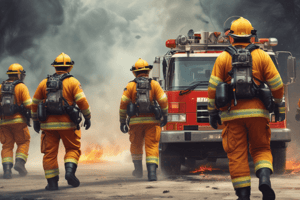Podcast
Questions and Answers
What is the top priority when responding to an incident?
What is the top priority when responding to an incident?
- Life safety (correct)
- Firefighter health and safety
- Environmental conservation
- Property conservation
Which element is NOT part of the R.E.C.E.O.V.S framework?
Which element is NOT part of the R.E.C.E.O.V.S framework?
- Rescue
- Exposure
- Assessment (correct)
- Confinement
At what air cylinder capacity should transition out of operations be considered?
At what air cylinder capacity should transition out of operations be considered?
- 2250 PSI (correct)
- 500 PSI
- 3000 PSI
- 1500 PSI
What should a company identify prior to entry into a hazardous area?
What should a company identify prior to entry into a hazardous area?
In terms of firefighter responsibilities, what is the primary consideration when protecting exposures?
In terms of firefighter responsibilities, what is the primary consideration when protecting exposures?
What is the minimum number of firefighters required for a rapid intervention team (RIT)?
What is the minimum number of firefighters required for a rapid intervention team (RIT)?
Which tactical objective involves the appropriate deployment of hoseline and nozzle combination?
Which tactical objective involves the appropriate deployment of hoseline and nozzle combination?
Study Notes
Incident Priorities
- Life safety is the foremost priority in all emergency incidents.
- Firefighter health and safety must be maintained throughout operations.
- Incident stabilization involves controlling the scene to prevent further escalation.
- Property conservation focuses on minimizing damage to structures and belongings.
- Environmental conservation aims to protect the surrounding ecosystem from hazards.
R.E.C.E.O.V.S
- Rescue involves saving individuals in immediate danger.
- Exposure prevention targets limiting fire spread to adjacent structures.
- Confinement is the containment of the fire to a specific area.
- Extinguishment refers to the process of putting out the fire effectively.
- Overhaul entails searching for hidden fire and ensuring complete extinguishment.
- Ventilation is necessary to clear smoke and heat from the area.
- Salvage focuses on protecting property from water and fire damage during firefighting efforts.
Air Management
- Air levels must be monitored every time crews enter a new area or ascend to another floor.
- Establishing an exit strategy before entry is crucial for safety.
- Transition out of operations should commence when air supply drops to 50% capacity (approximately 2250 PSI).
Engine Companies Tactical Objectives
- Size-up the situation to assess the fire and its potential hazards.
- Confine the fire by deploying hoselines to separate it from occupants and potential victims.
- Efficiently extinguish the fire using the appropriate hoseline and nozzle combinations.
- Protect exposures by prioritizing life safety and preventing fire spread to adjacent areas.
- Conduct primary searches for victims in major interior exposures, such as upper floors or adjoining businesses.
- Ensure a reliable water supply for effective firefighting operations.
- Rapid Intervention Teams (RIT) must consist of a minimum of four firefighters, including at least one officer.
Studying That Suits You
Use AI to generate personalized quizzes and flashcards to suit your learning preferences.
Description
This quiz covers essential priorities and strategies in firefighting incidents. Topics include life safety, R.E.C.E.O.V.S procedures, and air management techniques. Enhance your understanding of how to effectively respond to emergencies while ensuring the safety of both individuals and property.




